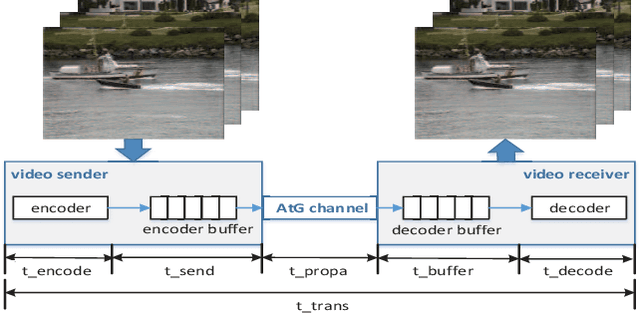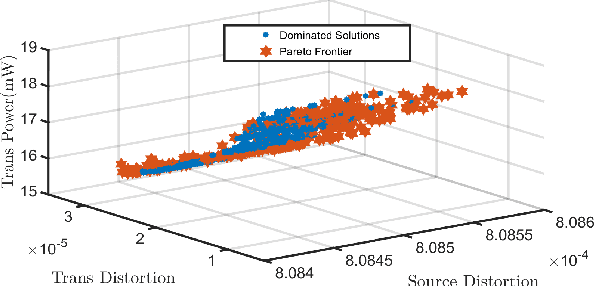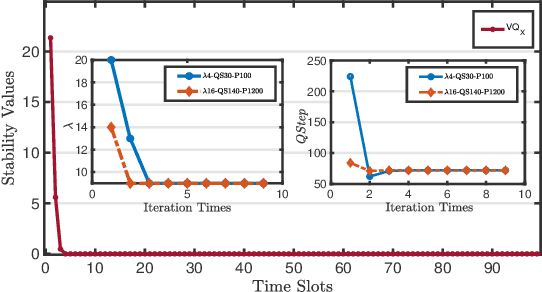Haijun Zhang
Jamming Identification with Differential Transformer for Low-Altitude Wireless Networks
Aug 17, 2025Abstract:Wireless jamming identification, which detects and classifies electromagnetic jamming from non-cooperative devices, is crucial for emerging low-altitude wireless networks consisting of many drone terminals that are highly susceptible to electromagnetic jamming. However, jamming identification schemes adopting deep learning (DL) are vulnerable to attacks involving carefully crafted adversarial samples, resulting in inevitable robustness degradation. To address this issue, we propose a differential transformer framework for wireless jamming identification. Firstly, we introduce a differential transformer network in order to distinguish jamming signals, which overcomes the attention noise when compared with its traditional counterpart by performing self-attention operations in a differential manner. Secondly, we propose a randomized masking training strategy to improve network robustness, which leverages the patch partitioning mechanism inherent to transformer architectures in order to create parallel feature extraction branches. Each branch operates on a distinct, randomly masked subset of patches, which fundamentally constrains the propagation of adversarial perturbations across the network. Additionally, the ensemble effect generated by fusing predictions from these diverse branches demonstrates superior resilience against adversarial attacks. Finally, we introduce a novel consistent training framework that significantly enhances adversarial robustness through dualbranch regularization. Simulation results demonstrate that our proposed methodology is superior to existing methods in boosting robustness to adversarial samples.
Efficient Edge LLMs Deployment via HessianAware Quantization and CPU GPU Collaborative
Aug 10, 2025Abstract:With the breakthrough progress of large language models (LLMs) in natural language processing and multimodal tasks, efficiently deploying them on resource-constrained edge devices has become a critical challenge. The Mixture of Experts (MoE) architecture enhances model capacity through sparse activation, but faces two major difficulties in practical deployment: (1) The presence of numerous outliers in activation distributions leads to severe degradation in quantization accuracy for both activations and weights, significantly impairing inference performance; (2) Under limited memory, efficient offloading and collaborative inference of expert modules struggle to balance latency and throughput. To address these issues, this paper proposes an efficient MoE edge deployment scheme based on Hessian-Aware Quantization (HAQ) and CPU-GPU collaborative inference. First, by introducing smoothed Hessian matrix quantization, we achieve joint 8-bit quantization of activations and weights, which significantly alleviates the accuracy loss caused by outliers while ensuring efficient implementation on mainstream hardware. Second, we design an expert-level collaborative offloading and inference mechanism, which, combined with expert activation path statistics, enables efficient deployment and scheduling of expert modules between CPU and GPU, greatly reducing memory footprint and inference latency. Extensive experiments validate the effectiveness of our method on mainstream large models such as the OPT series and Mixtral 8*7B: on datasets like Wikitext2 and C4, the inference accuracy of the low-bit quantized model approaches that of the full-precision model, while GPU memory usage is reduced by about 60%, and inference latency is significantly improved.
Model Splitting Enhanced Communication-Efficient Federated Learning for CSI Feedback
Jun 04, 2025Abstract:Recent advancements have introduced federated machine learning-based channel state information (CSI) compression before the user equipments (UEs) upload the downlink CSI to the base transceiver station (BTS). However, most existing algorithms impose a high communication overhead due to frequent parameter exchanges between UEs and BTS. In this work, we propose a model splitting approach with a shared model at the BTS and multiple local models at the UEs to reduce communication overhead. Moreover, we implant a pipeline module at the BTS to reduce training time. By limiting exchanges of boundary parameters during forward and backward passes, our algorithm can significantly reduce the exchanged parameters over the benchmarks during federated CSI feedback training.
COutfitGAN: Learning to Synthesize Compatible Outfits Supervised by Silhouette Masks and Fashion Styles
Feb 12, 2025



Abstract:How to recommend outfits has gained considerable attention in both academia and industry in recent years. Many studies have been carried out regarding fashion compatibility learning, to determine whether the fashion items in an outfit are compatible or not. These methods mainly focus on evaluating the compatibility of existing outfits and rarely consider applying such knowledge to 'design' new fashion items. We propose the new task of generating complementary and compatible fashion items based on an arbitrary number of given fashion items. In particular, given some fashion items that can make up an outfit, the aim of this paper is to synthesize photo-realistic images of other, complementary, fashion items that are compatible with the given ones. To achieve this, we propose an outfit generation framework, referred to as COutfitGAN, which includes a pyramid style extractor, an outfit generator, a UNet-based real/fake discriminator, and a collocation discriminator. To train and evaluate this framework, we collected a large-scale fashion outfit dataset with over 200K outfits and 800K fashion items from the Internet. Extensive experiments show that COutfitGAN outperforms other baselines in terms of similarity, authenticity, and compatibility measurements.
FCBoost-Net: A Generative Network for Synthesizing Multiple Collocated Outfits via Fashion Compatibility Boosting
Feb 03, 2025



Abstract:Outfit generation is a challenging task in the field of fashion technology, in which the aim is to create a collocated set of fashion items that complement a given set of items. Previous studies in this area have been limited to generating a unique set of fashion items based on a given set of items, without providing additional options to users. This lack of a diverse range of choices necessitates the development of a more versatile framework. However, when the task of generating collocated and diversified outfits is approached with multimodal image-to-image translation methods, it poses a challenging problem in terms of non-aligned image translation, which is hard to address with existing methods. In this research, we present FCBoost-Net, a new framework for outfit generation that leverages the power of pre-trained generative models to produce multiple collocated and diversified outfits. Initially, FCBoost-Net randomly synthesizes multiple sets of fashion items, and the compatibility of the synthesized sets is then improved in several rounds using a novel fashion compatibility booster. This approach was inspired by boosting algorithms and allows the performance to be gradually improved in multiple steps. Empirical evidence indicates that the proposed strategy can improve the fashion compatibility of randomly synthesized fashion items as well as maintain their diversity. Extensive experiments confirm the effectiveness of our proposed framework with respect to visual authenticity, diversity, and fashion compatibility.
BC-GAN: A Generative Adversarial Network for Synthesizing a Batch of Collocated Clothing
Feb 03, 2025



Abstract:Collocated clothing synthesis using generative networks has become an emerging topic in the field of fashion intelligence, as it has significant potential economic value to increase revenue in the fashion industry. In previous studies, several works have attempted to synthesize visually-collocated clothing based on a given clothing item using generative adversarial networks (GANs) with promising results. These works, however, can only accomplish the synthesis of one collocated clothing item each time. Nevertheless, users may require different clothing items to meet their multiple choices due to their personal tastes and different dressing scenarios. To address this limitation, we introduce a novel batch clothing generation framework, named BC-GAN, which is able to synthesize multiple visually-collocated clothing images simultaneously. In particular, to further improve the fashion compatibility of synthetic results, BC-GAN proposes a new fashion compatibility discriminator in a contrastive learning perspective by fully exploiting the collocation relationship among all clothing items. Our model was examined in a large-scale dataset with compatible outfits constructed by ourselves. Extensive experiment results confirmed the effectiveness of our proposed BC-GAN in comparison to state-of-the-art methods in terms of diversity, visual authenticity, and fashion compatibility.
Spectrum Sharing in Satellite-Terrestrial Integrated Networks: Frameworks, Approaches, and Opportunities
Jan 06, 2025



Abstract:To accommodate the increasing communication needs in non-terrestrial networks (NTNs), wireless users in remote areas may require access to more spectrum than is currently allocated. Terrestrial networks (TNs), such as cellular networks, are deployed in specific areas, but many underused licensed spectrum bands remain in remote areas. Therefore, bringing NTNs to a shared spectrum with TNs can improve network capacity under reasonable interference management. However, in satellite-terrestrial integrated networks (STINs), the comprehensive coverage of a satellite and the unbalanced communication resources of STINs make it challenging to effectively manage mutual interference between NTN and TN. This article presents the fundamentals and prospects of spectrum sharing (SS) in STINs by introducing four SS frameworks, their potential application scenarios, and technical challenges. Furthermore, advanced SS approaches related to interference management in STINs and performance metrics of SS in STINs are introduced. Moreover, a preliminary performance evaluation showcases the potential for sharing the spectrum between NTN and TN. Finally, future research opportunities for SS in STINs are discussed.
Heavy-Ball Momentum Accelerated Actor-Critic With Function Approximation
Aug 13, 2024Abstract:By using an parametric value function to replace the Monte-Carlo rollouts for value estimation, the actor-critic (AC) algorithms can reduce the variance of stochastic policy gradient so that to improve the convergence rate. While existing works mainly focus on analyzing convergence rate of AC algorithms under Markovian noise, the impacts of momentum on AC algorithms remain largely unexplored. In this work, we first propose a heavy-ball momentum based advantage actor-critic (\mbox{HB-A2C}) algorithm by integrating the heavy-ball momentum into the critic recursion that is parameterized by a linear function. When the sample trajectory follows a Markov decision process, we quantitatively certify the acceleration capability of the proposed HB-A2C algorithm. Our theoretical results demonstrate that the proposed HB-A2C finds an $\epsilon$-approximate stationary point with $\oo{\epsilon^{-2}}$ iterations for reinforcement learning tasks with Markovian noise. Moreover, we also reveal the dependence of learning rates on the length of the sample trajectory. By carefully selecting the momentum factor of the critic recursion, the proposed HB-A2C can balance the errors introduced by the initialization and the stoschastic approximation.
Joint Source-Channel Optimization for UAV Video Coding and Transmission
Aug 13, 2024



Abstract:This paper is concerned with unmanned aerial vehicle (UAV) video coding and transmission in scenarios such as emergency rescue and environmental monitoring. Unlike existing methods of modeling video source coding and channel transmission separately, we investigate the joint source-channel optimization issue for video coding and transmission. Particularly, we design eight-dimensional delay-power-rate-distortion models in terms of source coding and channel transmission and characterize the correlation between video coding and transmission, with which a joint source-channel optimization problem is formulated. Its objective is to minimize end-to-end distortion and UAV power consumption by optimizing fine-grained parameters related to UAV video coding and transmission. This problem is confirmed to be a challenging sequential-decision and non-convex optimization problem. We therefore decompose it into a family of repeated optimization problems by Lyapunov optimization and design an approximate convex optimization scheme with provable performance guarantees to tackle these problems. Based on the theoretical transformation, we propose a Lyapunov repeated iteration (LyaRI) algorithm. Extensive experiments are conducted to comprehensively evaluate the performance of LyaRI. Experimental results indicate that compared to its counterparts, LyaRI is robust to initial settings of encoding parameters, and the variance of its achieved encoding bitrate is reduced by 47.74%.
Pilot-Aided Joint Time Synchronization and Channel Estimation for OTFS
Aug 08, 2024



Abstract:In this letter, we propose a joint time synchronization and channel estimation (JTSCE) algorithm with embedded pilot for orthogonal time frequency space (OTFS) systems. It completes both synchronization and channel estimation using the same pilot signal. Unlike existing synchronization and channel estimation algorithms based on embedded pilots, JTSCE employs a maximum length sequence (MLS) rather than an isolated signal as the pilot. Specifically, JTSCE first explores the autocorrelation properties of MLS to estimate timing offset (TO) and channel delay taps. After obtaining these types of delay taps, the closed-form estimation expressions of the Doppler and channel gain of each propagation path are derived. Extensive simulation results indicate that compared to its counterparts, JTSCE achieves better bit error rate (BER) performance, close to that with perfect time synchronization and channel state information.
 Add to Chrome
Add to Chrome Add to Firefox
Add to Firefox Add to Edge
Add to Edge